A wide range of varieties of bee Honey, propolis and pollen of the highest quality. All harvested by local beekeepeers all over Spain using sustainable practices. Furthermore, these natural products will help you to strengthen your health in a natural way!
 Multi-flower honey Apícola Moreno 1 Kg9.50 €Raw multi-flower or multi-flower honey 1. Characteristics of multi flower honey of Apícola Moreno 1 Kg Multifloral honey has an amber to brown color, but it will depend on the type of flowers or myelates, so it can take very light to very dark colors. a) New Harvest Multi-flower honey is harvested throughout the year from […]
Multi-flower honey Apícola Moreno 1 Kg9.50 €Raw multi-flower or multi-flower honey 1. Characteristics of multi flower honey of Apícola Moreno 1 Kg Multifloral honey has an amber to brown color, but it will depend on the type of flowers or myelates, so it can take very light to very dark colors. a) New Harvest Multi-flower honey is harvested throughout the year from […] Heather honey Apícola Moreno 1 Kg10.90 €Raw heather honey 1. Characteristics of heather honey of Apícola Moreno: The honey has a very dark amber color reaching black. When crystallized, it takes on a brown colour with clearly reddish tones. a) New Harvest The heather honey is harvested every year at a different time, as the flowering of the heather is early […]
Heather honey Apícola Moreno 1 Kg10.90 €Raw heather honey 1. Characteristics of heather honey of Apícola Moreno: The honey has a very dark amber color reaching black. When crystallized, it takes on a brown colour with clearly reddish tones. a) New Harvest The heather honey is harvested every year at a different time, as the flowering of the heather is early […] Arbutus honey, Antonio Simón 500 g9.90 €Organic strawberry tree honey by Antonio Simón Raw honey 1. Characteristics of organic arbutus honey A jar of ecological strawberry tree honey from a local beekeeper of Spain. a) New Harvest Antomio Simón’s arbutus honey is harvested at the end of summer. The harvest is homogeneous over time although it is negatively affected by high […]
Arbutus honey, Antonio Simón 500 g9.90 €Organic strawberry tree honey by Antonio Simón Raw honey 1. Characteristics of organic arbutus honey A jar of ecological strawberry tree honey from a local beekeeper of Spain. a) New Harvest Antomio Simón’s arbutus honey is harvested at the end of summer. The harvest is homogeneous over time although it is negatively affected by high […]
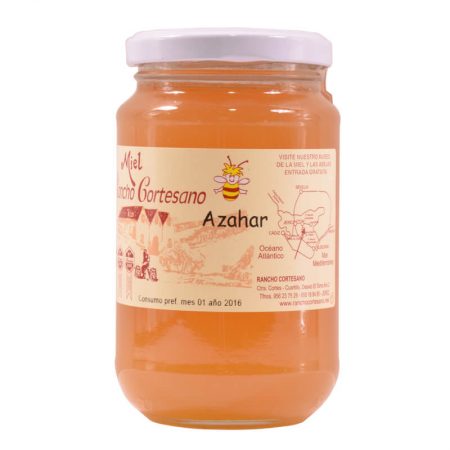 Orange Blossom Honey Rancho Cortesano 500 g7.90 €Raw orange blossom honey 1. Characteristics of organic orange blossom honey Orange blossom honey is clear and lighter the more nectar it has of the lemon blossom, reaching even a pure white. a) New Harvest A glass jar of orange blossom honey from a local beekeeper. b) Maximum quality: 100% raw honey This honey has […]
Orange Blossom Honey Rancho Cortesano 500 g7.90 €Raw orange blossom honey 1. Characteristics of organic orange blossom honey Orange blossom honey is clear and lighter the more nectar it has of the lemon blossom, reaching even a pure white. a) New Harvest A glass jar of orange blossom honey from a local beekeeper. b) Maximum quality: 100% raw honey This honey has […]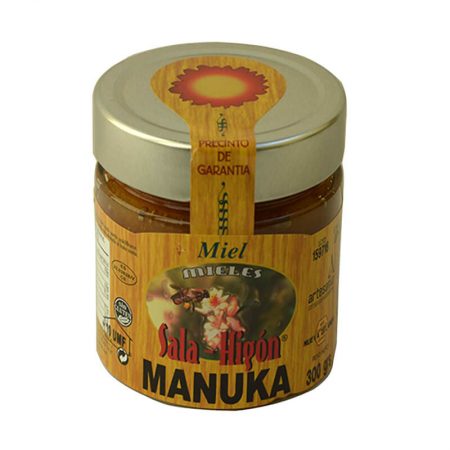 Manuka Honey Sala e Higón 300 g28.90 €Raw honey from Manuka 1. Characteristics of the honey of Manuka de Sala e Higón Manuka honey from the flowers of the native shrub of New Zealand and Australia, Leptospermum-scoparium, has an amber colour with orange hints. a) New Harvest Manuka honey is harvested in the southern hemisphere in spring. b) Aroma Manuka honey is […]
Manuka Honey Sala e Higón 300 g28.90 €Raw honey from Manuka 1. Characteristics of the honey of Manuka de Sala e Higón Manuka honey from the flowers of the native shrub of New Zealand and Australia, Leptospermum-scoparium, has an amber colour with orange hints. a) New Harvest Manuka honey is harvested in the southern hemisphere in spring. b) Aroma Manuka honey is […]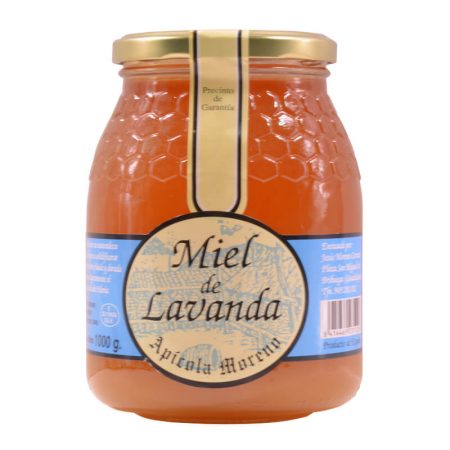 Lavender Honey Apícola Moreno 1 Kg10.90 €Raw lavender honey 1. Characteristics of lavender honey of Apícola Moreno Lavender honey has an amber color, lighter the more lavandin or savory (Satureja montana) it has, and darker when it has more myelates. a) New Harvest Lavender honey is harvested in summer and is very negatively affected by periods of drought and high winds. […]
Lavender Honey Apícola Moreno 1 Kg10.90 €Raw lavender honey 1. Characteristics of lavender honey of Apícola Moreno Lavender honey has an amber color, lighter the more lavandin or savory (Satureja montana) it has, and darker when it has more myelates. a) New Harvest Lavender honey is harvested in summer and is very negatively affected by periods of drought and high winds. […]
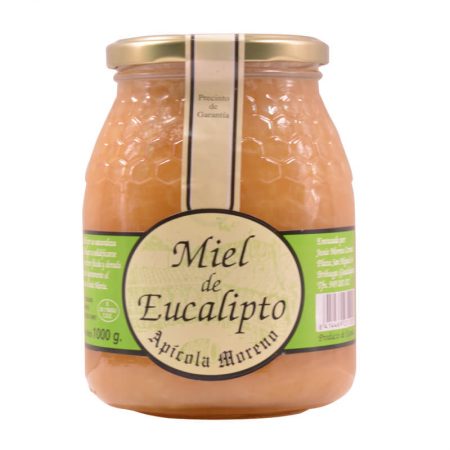 Eucalyptus honey Apícola Moreno 1 Kg10.90 €Raw eucalyptus honey 1. Characteristics of eucalyptus honey of Apícola Moreno Eucalyptus honey is light amber in colour with greenish reflections, but if it contains contributions from other plants, such as heather and brooms, it takes on darker colours. a) New Harvest Eucalyptus honey is harvested in summer, although it is sometimes also harvested in […]
Eucalyptus honey Apícola Moreno 1 Kg10.90 €Raw eucalyptus honey 1. Characteristics of eucalyptus honey of Apícola Moreno Eucalyptus honey is light amber in colour with greenish reflections, but if it contains contributions from other plants, such as heather and brooms, it takes on darker colours. a) New Harvest Eucalyptus honey is harvested in summer, although it is sometimes also harvested in […] Pollen Apícola Moreno 500 g12.50 €Dry pollen 1. Characteristics of the pollen of Apícola Moreno 500 g Glass filled with 100% Pure Honey Bee Pollen in granules. This depending on the year may have darker or lighter colors a) New Harvest Pollen is collected during the spring primarily b) Aroma Pollen has different fruity flavors. However, do not look for […]
Pollen Apícola Moreno 500 g12.50 €Dry pollen 1. Characteristics of the pollen of Apícola Moreno 500 g Glass filled with 100% Pure Honey Bee Pollen in granules. This depending on the year may have darker or lighter colors a) New Harvest Pollen is collected during the spring primarily b) Aroma Pollen has different fruity flavors. However, do not look for […] Meloja with cider Rancho Cortesano 500 g8.50 €Meloja or arrope with cider (pumpkin) 1. Characteristics of Meloja with cider A glass jar of “meloja” with cider An ancient beekeepers’ dessert made with honey and walnuts a) Aroma The meloja or arrope with cider has a sweet, toasty taste. b) Ingredients Made with high-quality honey from local beekeepers No added sugars c) Benefits […]
Meloja with cider Rancho Cortesano 500 g8.50 €Meloja or arrope with cider (pumpkin) 1. Characteristics of Meloja with cider A glass jar of “meloja” with cider An ancient beekeepers’ dessert made with honey and walnuts a) Aroma The meloja or arrope with cider has a sweet, toasty taste. b) Ingredients Made with high-quality honey from local beekeepers No added sugars c) Benefits […]
The finest selection of raw honeys, propolis and pollen, mainly from Spanish local beekeepers all over Spain.
Index:
|
Summary: Raw honey is a fantastic food that we have been taking for millennia. Furhtermore, it is rich in vitamins and other nutrients that provides great health benefits. Also, in our store in Las Rozas de Madrid we offer a fantastic selection of high-quality honeys from local beekeepers all over Spain. Honeys from eucalyptus, lavender, rosemary, thyme, etc.
Related studies: Where to buy raw bee honey–Unpasteurized raw honey-The best designations of origin for honey-The most expensive honeys in the world.
1. Our best selection of raw honeys
Firstly, we show you the most important information about our raw and pure honey:
a) Highest quality: 100% raw honey
All the honey that we offer in our shop is raw honey, that is to say, honey that has not been filtered and pasteurized. Therefore, real honey that preserves all the natural enzimes, pollen and floral essence.
b) Colour
The color and taste of honey depend on the plants that bees have visited. Consequently, the color of honey can vary from very light almost white colours to dark and even to black color. Furthermore, many of them take amber colour with reddish, grayish or greenish reflections. However, these variations of color depend on suspended particles like pollen and minerals.
In addition, we show you a table with the different colours that you can find in a real honey.

Photo 1: Colour grading of honey
c) Certify the quality
Furthermore, we have visited all our beekeepers, their packing rooms and their apiaries, in order to ensure they follow sustainables and responsible beekeeping practices. Likewise, we have checked their certificates, especially in organic beekeeping.
d) Ecological and conventional
We offer both organic certified and conventional honey of high-quality.
e) No advisables consumers
Do not feed honey to infants under two years old. Also, people suffering from diabetes should also be careful and ask a doctor.
f) Gift of nature
Moreover, honey is one of the few foods that nature gives us, where no living being suffers.
g) Government controls
Similarly, all the honey has passed all spanish state controls laws.
h) Beekeeping and sustainable production
When we visit the apiaries and meet the beekeepers, wemake sure that all environment and animal wellfare care have been taken.
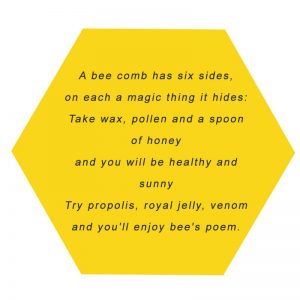
Photo 2: Bee poem
i) Rural development
In addition, beekeeping play a important rolle in rural areas and in our our natural environment. They are esential for the polinization of crops and labor creation of rural areas.
2. Raw and pure beehoney vs pasteurized
Pure and raw honey is a natural product that comes from plants through the intermediary of bees. Plants supply food to bees in two ways:
- The nectar produced by the flowers of the plants
- By substances exuded by insects and stingers, called myelates.
a) How is honey elaborted?
First of all, the bees collect nectar and myelates from plants, keep them in their crop. At the same time , transporting pollen from the flower to flower and carrying out the olinitation.
Also, in the bee’s crop, the raw material is mixed with its saliva, which fluidizes it and enriches it with enzymes, and with biochemical catalysts that participate in the transformation of honey sugars. Then, once the bee has filled its crop, it moves to the hive, in order to empty the contents in the rest of the beehive.
Video 1: Honey production
Then, once the pecorator bees bring it to the hive, they pass the nectar to their sister bees one to another. In the same way, this nectar or honeydew is passed from one to the other. Therefore, it goes from stomach to stomach in order to enrich it, lower its content in water and transform it into honey.
b) The time of harvesting
Finally, bees put this nectar which could already be honey in the cells of the hive. Here, its water content decreases even more in contact with outside temperture. After, when it reaches a sugar concentration between 70 and 80%, bees make to seal off this honey in each cell. In this moment honey is the ready for harvesting. Approximately when 80% of the cells are sealed off, the honey is at its optimum moment.
c) Practices against quality
Some beekeepers, in order to obtain higher yields, harvest honey from before is ready. In other words, this honey is not made yet and has a higher water content. These practices can ferment the honey due to its high water concentration. In addition, this is honey with more water that it should have, a honey of lower quality.
In another hand, we work with beekeepers which are commited with the quality. Also, our beekeepers are involved in every steps, from managing the hives, to bottling the honey. Consequently, garanting the best qualitythey make sure that we offer the finest raw honey.
“Obtained in a natural and environmentally friendly way”.
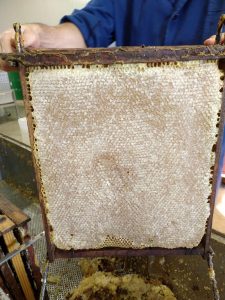
Photo 3: Unoperated honeycomb
d) Symbiotic relation
Flowers provide bees with food, but they receive polinitation in return, so they make a symbiotic relationship. When the bees collect nectar from the flowers, the bees soak up pollen. When the bee visits another flower, it spreads the pollen on other flowers and fertilizes them. In this way, the plant gives food to the bee, but it has to spend less energy to produce large amounts of pollen as anemophilous plants do, which transport their pollen with the wind.
e) How to differentiate them?
How to differentiate a high-quality honey with a low quality or adulterated honey. The answer is easy when adulteration is very clear, but it is not so easy, when the adulteration is more sophisticated. In general, when we buy a raw honey, we have to take into account the following points
- If it is crystallized, it indicates its high-quality
- It has a great flavor
- It can’t be very liquid.
- Avoid very low prices
- Trying to buy honey from local beekeepers
In another words, these would be 5 basic points to ensure that the honey you buy is a high-quality raw honey. However, you can find more information in our article “Raw unpasteurized honey”.
3. Ecological or organic honey
Secondly, many of us wonder if there are differences between organic and conventional honey. From the visual and taste point of view there is no difference, but there is a difference in terms of quality control and production characteristics.
a) What is organic honey? Raw organic honey vs conventional raw honey
Organic honey is honey with a organic certificate. To get this certificate, beehives must follow a stricter guidelines of ecologial beekeeping. For example, they should bring his hives to organic fields and use only organic treatments. Consequently, organic beekeeping must comply with more stricter environmental requirements and controls than conventional honey.
In summary, the differences between organic and conventional honey are how beekeepers work and the honey bees are kept.
Furthermore, it must be taken into account that bees cannot survive without human control. The diseases they suffer will eventually kill the entire hive if left untreated. Therefore, a hive must always be treated even in remote places.
b) Honey with more governmental control only?
Organic or ecological honey uses only organic products, such as thymol in the care of its bees. Conventional honey, on the other hand, may use chemical or pharmaceutical products, although all chemical products are controlled by a veterinarian.
Commercial honey |
Raw honey |
Organic honey |
|
|
|
Table 1: Differences between the different types of honey.
“The finest selection of organic and non-organic honeys”.
4. Composition of raw and pure honey:
Honey is composed primarly of glucose and fructose, but also contains other components. However, this composition varies, depending on several factors. Factors that we will see below:
- Floral source or source of myelate
- Soil conditions
- Race of bees
- Bee health status
- Time of year, etc.
In general, the honeys coming from myelates (heather, forest, holm oak, oak…) are darker honeys than the light honeys, which come from the nectar of the flowers (orange blossom honey, rosemary, thyme, eucalyptus…). Likewise, dark honeys have a high concentration of minerals. On the other hand, light honeys are richer in nectar and antioxidants.
Specifying a little more, in honey we find the following nutrients:
Firstly, the composition of honey can be divided into two groups, the main element, sugar that sccountd for 95 to 99% of honey dry matter. Also, it contains many other components.
a) Primarly components:
On average, the major components are as follows:
Component |
Percentage (%) |
| Water | 17 |
| Glucose | 31 |
| Levulose | 38 |
| Maltose | 7.5 |
| Sucrose | 7.5 |
| Other sugars |
Table 2: Primarly components of honey.
Quality honeys are usually 17% water, although the legal limit is 21%. Likewise, in the case of the calluna (heather) honey, its humidity usually reaches 23%.
On the other hand, the set of sugars constitutes between 95 and 99% of all dry matter.
b) Other components
Minor components: organic acids, amino acids and proteins, enzymes (glucose invertase, glucose oxidase, amylases α and β from bee saliva, large amount of water-soluble vitamins, carotenoid pigments (red), flavonoids (yellow) and minerals.
5. Properties of honey:
First of all, honey is a completely natural product with enormous medicinal and healthy properties. Therefore, a food that everyone should take daily.
Among the most important properties, we can name the following:
- Pure honey help to cures or reduces intestinal problems, stomach ulcers, help to fall asleep, constipation, sore throat.
- It is an important source of energy and gives muscle vigor.
- In its external use, it is ideal for healing burns, wounds. Its high content in sugars and the enzyme glucose-oxidase, causes the release of hydrogen peroxide along with low water content, provides bactericidal and antiseptic conditions.
In addition to many other properties that are known by traditional wisdom, but that science has not yet demonstrated.
6. Where to buy raw or pure honey?
In other hands, finding pure honey on the market isn’t that easy. Especially if you’re looking for it in supermarkets where most of honey sold is pasteurized honey.
Therefore, in our shop located in Las Rozas de Madrid, you can find also a fantastic selection of pure and raw honey from Spain and Europe. They all come from serious and honest local beekeepers. As a result, we offer only real honey.
Type |
Advantages |
Disadvantages |
Recommendation |
| Supermarket |
|
|
|
| Gourmet shop |
|
|
|
| Specialized stores |
|
|
|
| Beekeeper |
|
|
|
| Online |
|
|
|
Table 3: Different options to buy quality honey.
* We have to inform who to buy from, because on the internet it sells low as high quality.
7. Our brands and beekeepers
We have selected beekeepers who are committed to quality, respectful and sustainable beekeeping practices. We only only offer high-quality honey, so everything in our store is real raw honey. In summary, we work with the following beekeepers:
Antonio Simón |
Apícola Moreno |
Como una Reina |
Obreras de Aliste |
| Phone number: 91 620 90 47 E-Mail:
correo@miel-antoniosimon.com Webpage: miel-antoniosimon.com/ |
Phone number: 949 28 10 21 | Phone number: 962 260 384 Webpage: www.comounareina.com | Phone number: 619 94 55 94 Webpage: www.lasobrerasdealiste.es
E-mail: info@lasobrerasdealiste.es |
 |
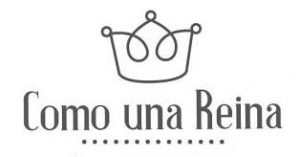 |
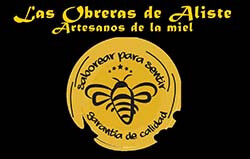 |
|
| Madrid | Guadalaja, no Do La Alcarria | Valencia | Zamora |
Table 4: Beekeepers we work with.
More companies we work with.
Rancho Cortesano |
Rika |
Valderromero |
Sala-Higón |
| Phone number: 956 23 75 28 E-Mail:
miel@eanchocortesano.net Webpage: www.ranchocortesano.net |
Phone number: 622 437 753
Web page: www.rikamiel.com E-mail: rika@rikamiel.com |
Phone number: 962 260 384 Webpage: www.comounareina.com | Phone number: 962 52 74 27 Webpage: latiendadelamiel.com
E-mail: info@lasobrerasdealiste.es |
 |
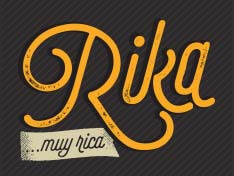 |
 |
 |
| Cádiz | Tenerife | La Alcarria, Guadalajara | Valencia |
Table 5: Beekeepers we work with.
All our beekeepers handles all steps from harvest to bottling
a) More brands
In Spain there are also thousands of beekeepers spread all over the country. We have selected these, and in the future we will add some more. This does not detract from the fact that you can also find other quality honeys.
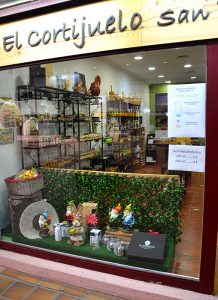
Photo 4: Our shop in Las Rozas de Madrid
7. FAQ
In addition, these are frequently asked questions:
-
Is honey good for your health?
Honey is a natural product that contains minerals and vitamins, which are very beneficial to health.
-
How can I make it crystallize before?
If we want to accelerate the crystallization, we must put the jar at a temperature close to 14 celsius degrees. At other temperatures it is delayed, and in case of high temperatures it liquifies.
-
Are these all Spanish honeys?
Almost all the honeys we sell are Spanish, but there are some from other countries. For instance, we bring honey from Germany, New Zeland, Hungary, Poland, Portugal….
-
Are all the honeys you sell here really Spanish?
We have visited almost all our beekeepers, their facilities and apiaries in order to ensure the highest quality of the honey we sell. For this reason, we can tell you that we sell real high-quality honey.
-
What consistency does it usually arrive with?
It depends on the variety and the time of the year. The dark honeys always arrive liquid, the rest of the honeys are sometimes solidified, with the exception of summer, when the heat makes them almost all liquid.
-
Can we heat honey?
If honey is heated in an infusion or coffee, it loses some properties, but few. However, the real problem is ti heat honey for long periods of time, as happens with pasteurised honeys.
-
Are our honeys kosher?
Any of our honeys have kosher certificate.
The english media BBC



